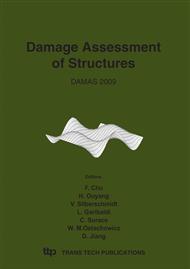p.733
p.741
p.749
p.757
p.767
p.775
p.785
p.793
p.803
Influence of Disbond Defects on the Dispersion Properties of Adhesive Bonding Structures
Abstract:
With increasing application of adhesive bonding structures, the quality assessment of adhesive bonding became critical. Ultrasonic approach was an acknowledged promising method in many Nondestructive testing (NDT) techniques. The research object was to use analytical models to develop a quantitative understanding of the affections in different situations on the dispersion properties. An improved global matrix method was introduced to compute the dispersive curves, which can effectively eliminate the instability for thicker layers and higher frequencies. In order to evaluate the disbond defect, the cohesive strength degradation mode and the spring mode were then adopted to describe the cohesive failure and the interface failure, respectively. In the paper, cohesive failure, interface failure and mixed failure were analyzed for the steel/adhesive layer/insulation layered structure. Interface failure induced the modes of multilayer structure to regress to the modes of single layers, while the cohesive failure made the dispersive curves move to the lower frequency direction, and changing the relative position of spring layer led the dispersive curves shift to the higher frequency direction. Among all the factors, the interface failure was dominant. Finally, the variety of the dispersive modes in a special frequency band (1~1.5MHz) was found that can be regarded as parameters of the adhesive bonding quality.
Info:
Periodical:
Pages:
767-774
Citation:
Online since:
June 2009
Authors:
Price:
Сopyright:
© 2009 Trans Tech Publications Ltd. All Rights Reserved
Share:
Citation:


